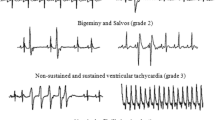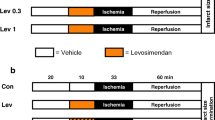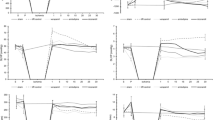Abstract
KATP channels are present in sarcolemmal and mitochondrial membranes. This study tests the hypothesis that opening mitochondrial KATP channels with Diazoxide (DZ) improves tolerance to cardioplegic ischemia during surgery. Twenty-two rabbit hearts were perfused with Krebs−Henseleit buffer (KHB) on a Langendorff apparatus and underwent 50 min of 37°C global ischemia with St Thomas' cardioplegia (STCP). Hearts were divided into three groups. Ten (control) received no pretreatment. Seven (DZ) received 10 min of 30 μM DZ, a selective mitochondrial KATP opener, in KHB before arrest with STCP containing 30 μM DZ. Five (5-HD + DZ) received 10 min of 100 μM sodium 5-hydroxydecanoate (5-HD), a selective mitochondrial KATP channel blocker, followed by 10 min of 30 μM DZ and 100 μM 5-HD in KHB before arrest with STCP + 30 μM DZ + 100 μM 5-HD. LV developed pressure (LVDP), dP/dt and coronary flow (CF) were measured after 60 min of reperfusion. Diazoxide pretreatment significantly improved the recovery of LV function and coronary flow compared to control (LVDP: 49 ± 5* vs. 31 ± 4; +dP/dtmax 927 ± 93 vs. 507 ± 85 mmHg/sec*; CF 33 ± 4 vs. 22 ± 2 ml/min, *p < 0.05). Mitochondria KATP channel blockade with 5-HD prevented DZ's salutary effect on the recovery of LV and vascular function. Diazoxide pretreatment protects the rabbit heart during cardioplegic ischemia by opening mitochondrial KATP channels. Opening mitochondrial KATP channels may be a new strategy for improving myocardial protection during cardiac surgery.
Similar content being viewed by others
References
Cole W, McPherson C, Sontag D: ATP-regulated potassium channels protect the myocardium against ischemia/reperfusion damage. Circ Res 69: 571–581, 1991
Gross GJ, Auchampach JA: Blockade of ATP-dependant potassium channels prevents myocardial preconditioning. Circ Res 70: 223–233, 1992
Galinanes M, Shattock MJ, Hearse DJ: Effects of potassium channel modulation during global ischaemia in isolated rat heart with and without cardioplegia. Cardiovasc Res 26: 1063–1068, 1992
Cohen N, Wise R, Wechsler A, Damiano R: Elective cardiac arrest with a hyperpolarizing adenosine triphosphate-sensitive potassium channel opener. A novel form of myocardial protection? J Thorac Cardiovasc Surg 106: 317–328, 1993
Menasche P, Kevelaitis E, Mouas C, Grousset C, Piwnica A, Bloch G: Preconditioning with potassium channel openers. A new concept for enhancing cardioplegic protection? J Thorac Cardiovasc Surg 110: 1606–1613, 1995
Feng J, Li HL, Rosenkranz ER: Pinacidil pretreatment extends ischemia tolerance to neonatal rabbit hearts. J Surg Res 90: 131–137, 2000
Sugimoto S, Iwashiro K, Monti F, Dawodu AA, Schiariti M, Puddu PE: The risk of myocardial stunning is decreased concentration-dependently by KATP channel activation with nicorandil before high K+ cardioplegia. Int J Cardiol 48: 11–25, 1995
Pignac J, Bourgouin J, Dumont L: Cold cardioplegia and the K+ channel modulator aprikalim (RP 52891): Improved cardioprotection in isolated ischemic rabbit hearts. Can J Physiol Pharmacol 72: 126–132, 1994
Dorman BH, Hebbar L, Clair MJ, Hinton R, Roy R, Spinale F: Potassium channel opener-augmented cardioplegia: Protection of myocyte contractility with chronic left ventricular function. Circulation 96: II253–259, 1997
Lopez JR, Jahangir R, Jahangir A, Shen WK, Terzic A: Potassium channel openers prevent potassium-induced calcium loading of cardiac cells: Possible implications in cardioplegia. J Thorac Cardiovasc Surg 112: 820–831, 1996
Grover GJ, Sleph PG: Protective effect of K(ATP) openers in ischemic rat hearts treated with a potassium cardioplegic solution. J Cardiovasc Pharmacol 26: 698–706, 1995
Noma A: ATP-regulated K+ channels in cardiac muscle. Nature 305: 147–148, 1983
Inoue I, Nagase H, Kishi K, Higuti T: ATP-sensitive K+ channels in the mitochondrial inner membrane. Nature 352: 244–247, 1991
Grover GJ, D'Alonzo AJ, Parham CS, Darbenzio RB: Cardioprotection with the KATP opener cromakalim is not correlated with ischemic myocardial action potential duration. J Cardiovasc Pharmacol 26: 145–152, 1995
Garlid KD, Paucek P, Yarov-Yarovoy V, Murray HN, Darbenzio RB, D'Alonzo AJ, Lodge NJ, Smith MA, Grover GJ: Cardioprotective effect of diazoxide and its interaction with mitochondrial ATP-sensitive K+ channels: Possible mechanism of cardioprotection. Circ Res 81: 1072–1082, 1997
Iwai T, Tanonaka K, Koshimizu M, Takeo S: Preservation of mitochondrial function by diazoxide during sustained ischaemia in the rat heart. Br J Pharmacol 129: 1219–1227, 2000
Fryer RM, Eells JT, Hsu AK, Henry MM, Gross GJ: Ischemic preconditioning in rats: Role of mitochondrial KATP channel in preservation of mitochondrial function. Am J Physiol 278: H305–H312, 2000
Hide EJ, Thiemermann C: Limitation of myocardial infarct size in the rabbit by ischaemic preconditioning is abolished by sodium 5-hydroxydecanoate. Cardiovasc Res 31: 941–946, 1996
Liu Y, Sato T, O'Rourke B, Marbán E: Mitochondrial ATP-dependent potassium channels novel effectors of cardioprotection? Circulation 97: 2463–2469, 1998
Sato T, Sasaki N, Seharaseyon J, O'Rourke B, Marbán E: Selective pharmacological agents implicate mitochondrial but not sarcolemmal KATP channels in ischemic cardioprotection. Circulation 101: 2418–2423, 2000
Pomerantz BJ, Robinson TN, Morrell TD, Heimbach JK, Banerjee A, Harken AH: Selective mitochondrial adenosine triphosphate-sensitive potassium channel activation is sufficient to precondition human myocardium. J Thorac Cardiovasc Surg 120: 387–392, 2000
Ghosh S, Standen NB, Galinanes M: Evidence for mitochondrial K ATP channels as effectors of human myocardial preconditioning. Cardiovasc Res 45: 934–940, 2000
Kevelaitis E, Oubenaissa A, Peynet J, Mouas C, Menasche P: Preconditioning by mitochondrial ATP-sensitive potassium channel openers: An effective approach for improving the preservation of heart transplants. Circulation 100 (suppl): II345–350, 1999
Jaburek M, Yarov-Yarovoy V, Paucek P, Garlid KD: State-dependent inhibition of the mitochondrial KATP channel by glyburide and 5-hydroxydecanoate. J Biol Chem 273: 13578–13582, 1998
Gross GJ, Fryer RM: Sarcolemmal versus mitochondrial ATP-sensitive K+ channels and myocardial preconditioning. Circ Res 84: 973–979, 1999
O'Rourke B: Myocardial K-ATP channels in preconditioning. Circ Res 87: 845–855, 2000
Pain T, Yang XM, Critz SD, Yue Y, Nakano A, Liu GS, Heusch G, Cohen MV, Downey JM: Opening of mitochondrial KATP channels triggers the preconditioned state by generating free radicals. Circ Res 87: 460–466, 2000
Obata T, Yamanaka Y: Block of cardiac ATP-sensitive K+ channels reduces hydroxyl radicals in the rat myocardium. Arch Biochem Biophys 378: 195–200, 2000
Baines CP, Liu GS, Birincioglu M, Critz SD, Cohen MV, Downey JM: Ischemic preconditioning depends on interaction between mitochondrial KATP channels and actin cytoskeleton. Am J Physiol 276: H1361–H1368, 1999
Grover GJ, D'Alonzo AJ, Garlid KD, Bajgar R, Lodge NJ, Sleph PG, Darbenzio RB, Hess TA, Smith MA, Paucek P, Atwal KS: Pharmacologic characterization of BMS-191095, a mitochondrial K(ATP) opener with no peripheral vasodilator or cardiac action potential shortening activity. J Pharmacol Exper Ther 297: 1184–1192, 2001
Rights and permissions
About this article
Cite this article
Feng, J., Li, H. & Rosenkranz, E.R. Diazoxide protects the rabbit heart following cardioplegic ischemia. Mol Cell Biochem 233, 133–138 (2002). https://doi.org/10.1023/A:1015554211010
Issue Date:
DOI: https://doi.org/10.1023/A:1015554211010




